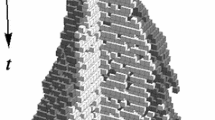Abstract
A one-dimensional cellular automaton with periodic boundary conditions may be viewed as a lattice of sites on a cylinder evolving according to a local interaction rule. A technique is described for finding analytically the set of attractors for such an automaton. Given any one-dimensional automaton rule, a matrixA is defined such that the number of fixed points on an arbitrary cylinder size is given by the trace ofA n, where the powern depends linearly on the cylinder size. More generally, the number of strings of arbitrary length that appear in limit cycles of any fixed period is found as the solution of a linear recurrence relation derived from the characteristic equation of an associated matrix. The technique thus makes it possible, for any rule, to compute the number of limit cycles of any period on any cylinder size. To illustrate the technique, closed-form expressions are provided for the complete attractor structure of all two-neighbor rules. The analysis of attractors also identifies shifts as a basic mechanism underlying periodic behavior. Every limit cycle can be equivalently defined as a set of strings on which the action of the rule is a shift of sizes/h; i.e., each string cyclically shifts bys sites inh iterations of the rule. The study of shifts provides detailed information on the structure and number of limit cycles for one-dimensional automata.
Similar content being viewed by others
References
Martin, O., Odlyzko, A., Wolfram, S.: Algebraic properties of cellular automata. Commun. Math. Phys.93, 219–259 (1984)
Guan, P., He, Y.: Exact results for deterministic cellular automata. J. Stat. Phys.43, 463 (1986)
Guan, P., He, Y.: Upper bound on the number of cycles in border-decisive cellular automata. Complex Systems1, 181 (1987)
Wolfram, S.: Theory and applications of cellular automata. Singapore: World Scientific 1986
Jen, E.: Global properties of cellular automata. J. Stat. Phys.43, 219 (1986)
Jen, E.: Linear cellular automata and recurring sequences in finite fields. Los Alamos National Laboratory Report LA-UR-87-2026. Commun. Math. Phys. (to appear)
Jen, E.: Invariant strings and pattern-recognizing properties of one-dimensional cellular automata. J. Stat. Phys.43, 243 (1986)
Hedlund, G.: Endomorphisms and automorphisms of the shift dynamical system. Math. Syst. Theory3, 320 (1969)
Lind, D. A.: Applications of ergodic theory and sofic systems to cellular automata in reference [1]
Boyle, M.: Constraints on the degree of a sofic homomorphism and the induced multiplication of measures on unstable sets. Israel J. Math.53, 52 (1986)
Jen, E.: Scaling of preimages in cellular automata. Complex Systems6, 1045–1062 (1987)
Wolfram, S.: Random sequence generation by cellular automata. Adv. Appl. Math.7, 123 (1986)
Author information
Authors and Affiliations
Additional information
Communicated by J. L. Lebowitz
Rights and permissions
About this article
Cite this article
Jen, E. Cylindrical cellular automata. Commun.Math. Phys. 118, 569–590 (1988). https://doi.org/10.1007/BF01221109
Received:
Revised:
Issue Date:
DOI: https://doi.org/10.1007/BF01221109




